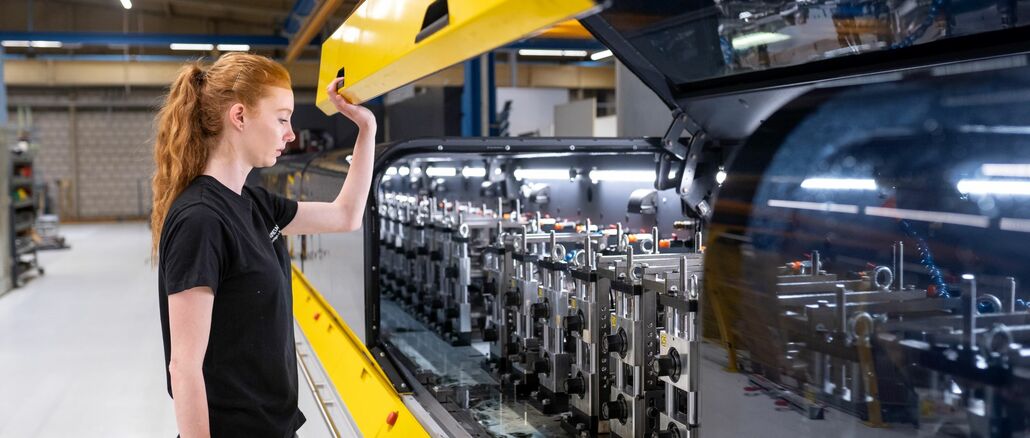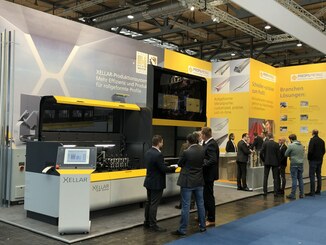
Roll-formed steel profiles are the preferred choice when it comes to energy efficiency, climate friendliness and resource conservation. Thanks to the positive energy balance of roll forming compared with other processes and the 100% recyclability of steel, roll-formed profiles are both inexpensive and sustainable, and meet current EU requirements for sustainable products.
The entire supply industry is currently facing explosive cost increases for electricity and gas. Manufacturers of energy-intensive products or companies with less energy-efficient processes are particularly hard hit. The roll forming process scores here with its very good energy efficiency and extremely positive environmental balance. In addition, the material utilization rate is close to one hundred percent.

© Tillmann Group
Material cycles for climate targets
In order to achieve the challenging climate targets, the European Commission has launched a legislative initiative for a sustainable product policy so that certain products are developed in such a way that they can be fed back into the material cycle again and again. The Federation of German Industries (BDI) is also aiming for this with its “Circular Economy” initiative and is calling for the decarbonization of products, among other things. This means that, in addition to the consistent avoidance or compensation of CO2 emissions, products and materials should be able to be seamlessly fed into and out of material cycles in the future.
“On the one hand, the corresponding specifications are intended to increase energy efficiency during production and operation. On the other hand, products should be durable, reusable and recyclable,” explains Ekkehard Böhm, Managing Director of the Tillmann Group and Chairman of the European Cold Rolled Section Association (ECRA). What is needed, he said, is a mix of innovation-driven improvements for Circular Economy products and common standards for sustainable product design. “In this context, the use of raw materials such as steel, stainless steel or other metals recovered through the high-quality recycling of waste can demonstrably make an important contribution to reducing CO2 emissions,” Böhm points out.
In the previous legislative period, the German government had already stipulated stricter inspection requirements for the use of materials from the circular economy by the contracting authorities by amending Section 45 of the Closed Substance Cycle Waste Management Act (KrWG). As part of its Green Deal, the European Commission now plans to propose binding minimum criteria and targets for green public procurement in industry-specific legislation.
Roll forming with excellent energy efficiency

© ECRA
“Overall, it can be said that the roll forming industry is well prepared for the planned legislative requirements,” explains Martin Kunkel, Managing Director of ECRA. “Since the material consumption and the weight of the workpieces are low, roll forming is a forming process that improves product properties in a resource-saving way compared to conventional processes.”
Material loss, for example, is significantly lower compared to machined components. Due to work hardening, roll-formed workpieces with lower material thicknesses achieve comparable mechanical strengths.
In addition to numerous legal requirements regarding climate neutrality, the current rise in energy prices is causing problems for many steel and metal production plants. For some companies, it even threatens their very existence. “Here, the rollforming industry with its cold-formed steel profiles is still coming through this energy crisis comparatively well,” Martin Kunkel emphasizes. “This is because the forming process associated with cold rolling eliminates the need to heat the semi-finished product, resulting in a relatively low overall energy requirement.”
In addition to the energy for the actual forming itself, energy is only consumed for the friction processes and the acceleration of the masses of the workpiece profile, tools and machine components. In addition, in the continuous process, the traveling mold components and the small contact surfaces during the acceleration processes have a positive effect on the energetic efficiency.
Resource-saving circular economy
Roll forming is also characterized by a high degree of flexibility in the process, a high degree of variability in the end products and low tooling costs. In contrast to deep-drawing processes or conventional sheet metal forming, roll forming can be used to produce very complex, thin-walled and yet highly resilient profiles in all conceivable designs and cross-sectional shapes and, above all, in any desired length with high precision and extremely quickly. Even high-strength steels can be processed by roll forming, which is particularly advantageous in lightweight construction.
Additional designs such as threading, offsets, embossing, recesses or prefabrications are also possible. The vertical range of manufacture is correspondingly high. Due to the process, material utilization is very high, as only residues are left over when entering the roll forming line as well as punching residues, which in the case of steel profiles can even be recycled one hundred percent and without any loss of quality. Roll-formed profiles are used, among other things, in elevator construction, escalators, as facade profiles, for rolling doors, in car washes, for shelving and LED lighting systems, as drawer pulls, in solar systems or toy car tracks.

© Profile metal
Background information
ECRA – European Cold Rolled Section Association – has been in existence since 1999 and is the trade association of European cold rolled section manufacturers. It represents the interests of the roll forming sector as part of the steel processing industry. In Germany, this sector, which is distinctly dominated by small and medium-sized enterprises, comprises around 5,000 employees in around 35 companies with total sales of around 1.6 billion euros (2020, source: Federal Statistical Office). Cold profiles are roll-formed from flat-rolled stock at room temperature on profiling lines by progressive bending. The main customer industries are the automotive, electrical, furniture and construction industries.
Web:
www.ecra-online.de

